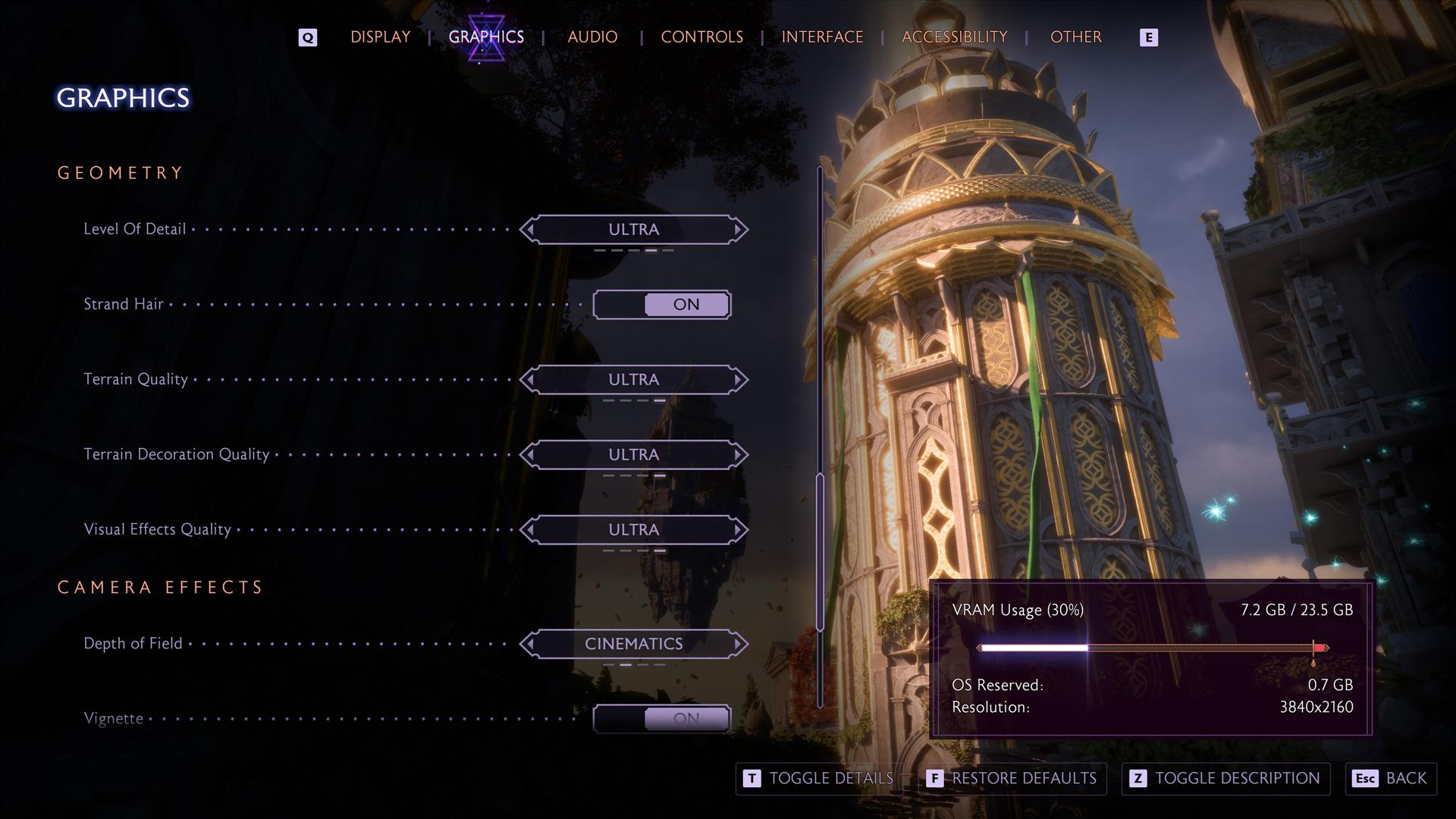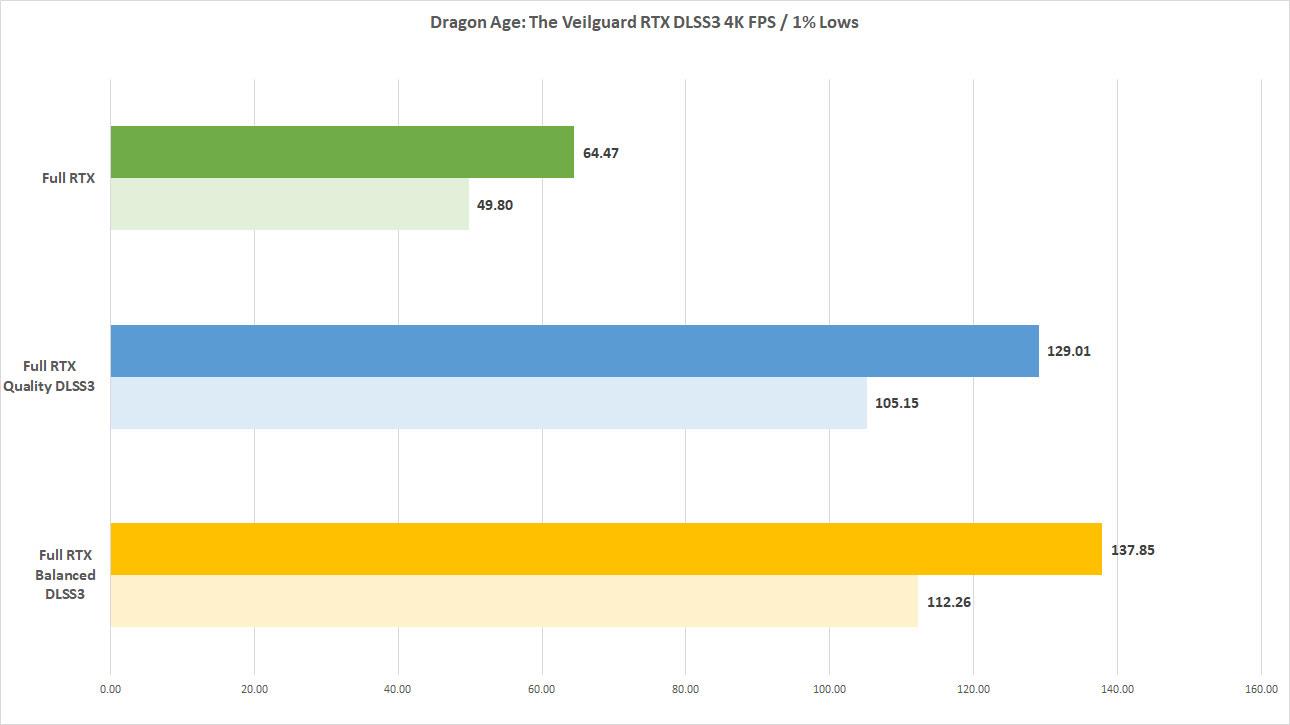
Dragon Age: The Veilguard NVIDIA Performance
Dragon Age The Veilguard is the fourth game in the Dragon Age franchise and it’s been a long time coming for this one. Formerly known as Dreadwolf, The Veilguard moved the series to a more action oriented style and seemed to have sold pretty well for EA and BioWare.
As with many AAA titles on the PC these days, Dragon Age The Veilguard incorporates a few NVIDIA RTX features. We have ray tracing for reflections and ambient occlusion. Reflections is pretty self explanatory while ambient occlusion simulates soft shadows which can occur from environmental lighting.
For better performance, NVIDIA’s DLSS 2 has been added as well as Frame Generation, the process to interpolate and inject frames into the game to improve framerate at a cost of latency. The Veilguard does have support for NVIDIA Reflex to help mitigate the increased latency when using Frame Generation so for those who want as much FPS as possible, the combination of Frame Generation and Reflex can provide a much better gaming experience when you turn these features on.
NVIDIA was kind enough to provide a copy of Dragon Age The Veilguard to test and today we’ll take it through my setup in what will be a swan song for my AMD 7800X3D system as I just recently purchased an AMD 9800X3D to take its place. We’ll play the game at 4K resolution and compare performances in various scenarios from enabling or disabling ray tracing as well as a few DLSS3 quality settings.
My test setup consisted of:
AMD Ryzen 7 7800X3D
TEAMGROUP T-Create Expert Overclocking 10L DDR5 64GB Kit (2 x 32GB) 6000MHz (PC5-48000)
ASRock B65-E PG Riptide WiFi motherboard
NVIDIA GeForce RTX 4090
Samsung 990 Pro 4TB SSD
LG OLED42C2PUA 42"
Since Dragon Age The Veilguard doesn’t have a built in benchmark, I played the game for a few hours to see if I could find a good place to do some controlled runs. In the end, I came back to the beginning of the game and decided to just run that through and capture the performance using FrameView. Each run was done three times and I took the averages of the scores, which you can see in the graphs below.
For the baseline score, I pretty much ran the game on the highest settings and the only thing I turned off was motion blue. You can see below the settings I ran the tests in. First up, we’ll get a baseline reading of the game as well as using DLSS without Frame Generation in both Quality and Balanced settings.



As you can see, the game runs pretty well at 4K with everything dialed up. Even without any DLSS2 settings, the game holds a nice average of 82.59 FPS with a 1% low above 60FPS. Granted, I’m on a higher end machine and using an RTX 4090 card, but if you do have a similar setup, you can be sure to just push everything to the maximum and you’ll be treated to a solid gaming experience at 4K.
You can, of course, run Dragon Age: The Veilguard with Frame Generation by itself. I don’t think there’s a need with the setup I tested, but you do get about a 53.40% uplift over the average FPS and more than 60% increase over the 1% lows. The caveat is that you get increased latency. Average latency without Frame Generation here was 27.99ms, but with Frame Generation on, it pushes it to 40.28ms. This is even with Reflex enabled.

Next, let’s try some DLSS3, which is DLSS2 with Frame Generation. Here, you can see even more of an improved performance over just the base line with Frame Generation. Another benefit with DLSS3 enabled is latency did improve as DLSS3 in Quality settings was averaging 34.83ms, a good 13.8% improvement.


Going to Balanced DLSS3, frame rates skyrocket to almost double that of the base line in both averages and 1% lows.
Dragon Age: The Veilguard supports two types of ray-tracing: reflections and ambient occlusion. I do like the implementation of ray-traced reflections in the game and as you can see in the screenshot below, the difference is noticeable in the water reflection of the barrel, wheel, and the sack in the middle of the screen. You actually don’t lose too much performance with RTX turned on. Averages dipped about 21.65% with the 1% lows dropping around 18%. As we’ve seen on many games in the past where performance really tanks when turning in ray-tracing, Dragon Age: The Veilguard fares pretty well here.




Let’s enable RTX and DLSS3 to see what we can push the performance to.

With Quality DLSS3 and RTX on, the 1% lows averages above the desired 60FPS. It doesn’t seem to get that much more of a performance increase going to Balanced DLSS3, so in this scenario I’d stick with Quality if you do want to enable it. There doesn’t seem to be an improvement in latency though as both Quality and Balanced DLSS3 averaged around 40ms, which is pretty much the same as the base line with Frame Generation enabled.
Dragon Age: The Veilguard seems to be a very well optimized game with good visuals and not a steep performance drop when enabling ray-tracing at 4K. This is one of the few current titles where if I was playing, I’d just leave everything as is with RTX enabled to enjoy the improved visuals and keeping Frame Generation off for the better latency since it’s more on the action side of things. If I was going to enable DLSS, Quality seems to hit that nice sweet spot of keeping the game above 60FPS in 1% lows as well as keeping latency around 28ms. I didn’t see any visual artifacts or anomalies and the game ran super well on my AMD setup with a NVIDIA RTX 4090 powering the graphics.
* The product in this article was sent to us by the developer/company.

About Author
I've been reviewing products since 1997 and started out at Gaming Nexus. As one of the original writers, I was tapped to do action games and hardware. Nowadays, I work with a great group of folks on here to bring to you news and reviews on all things PC and consoles.
As for what I enjoy, I love action and survival games. I'm more of a PC gamer now than I used to be, but still enjoy the occasional console fair. Lately, I've been really playing a ton of retro games after building an arcade cabinet for myself and the kids. There's some old games I love to revisit and the cabinet really does a great job at bringing back that nostalgic feeling of going to the arcade.
View Profile











